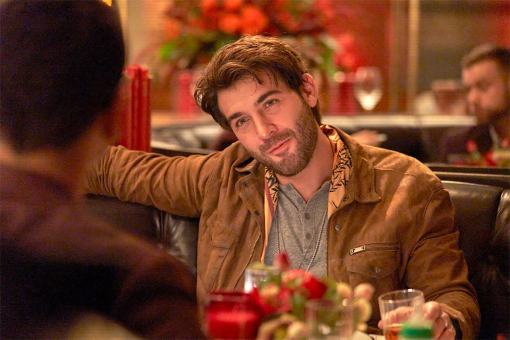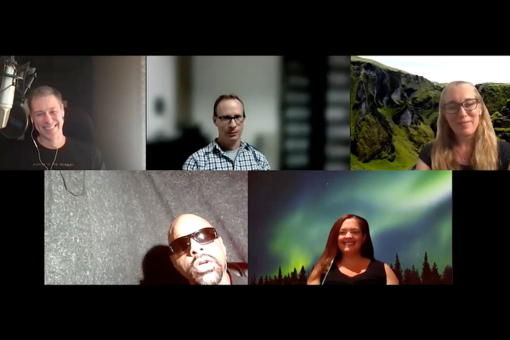How do blind people "watch" television? Turns out, they do it much the same way sighted people do, but with a little help from audio description, a field that is finally coming into its own.
Television Academy member and voice actor Roy Samuelson has been working hard both to provide and to promote audio description at its best for all kinds of projects.
He explains, "This is how blind people watch TV shows. Audio description is sometimes confused with closed captioning, but it's an entirely produced audio track that joins existing series. I consider it an adaptation. One of the cool things about audio description is that it's been around for 30 years.
While the concept and technology aren't new, the availability and number of titles that have audio tracks included are always growing. Samuelson says, "As of right now there are 6,200 titles that have audio description. That can include a feature film, it can include a series. So if a series has 20 episodes then those 20 are included in one title."
It doesn't hurt that the FCC has mandated audio description be included, at least in some television programming. "The FCC —the federal government — mandates broadcast television to have so many hours of audio description," Samuelson notes.
The FCC ruling also says that streaming services with over 50,000 subscribers are required to include audio description in their programming. The top five, according to the FCC are: Discovery, HGTV, History, TBS and USA. The FCC also notes that many of the "non-broadcast" companies do, in fact, include audio description.
Even before the requirement went into effect, many companies recognized the importance of taking blind audience members into account. Samuelson explains, "Netflix came out with a series that featured a blind character, and blind people couldn't watch it because it didn't have audio description.
"Netflix recognized that as being a problem because they are subscriber-based and they recognized the 30-some million blind and low-vision Americans — let alone 250 blind and low-vision worldwide — that this is market share. I believe that they recognize this is an opportunity for [them] to reach more subscribers. Because blind people have family members.
"This is an opportunity and Netflix recognize that. Amazon Prime with their Originals [Amazon Prime Studios' original series and movies] recognize that."
Along with the business opportunities for platforms that add audio description, the performers who provide these descriptions have also made strides in recognition.
"The Television Academy now recognizes audio description narrator's credits for television to be qualifying for membership," Samuelson explains. "So we can now vote for the Emmys. I've been working on that for five or six years; it finally came through. It went through all the membership [committee], it went through the board, everybody.
"So there's an accessibility here because audio description was created by blind people for blind people, and now blind experts, blind voices are the talents who are doing this work, and can finally join the Television Academy."
One impediment to wider adoption of audio description in the industry has been lack of awareness, but Samuelson says that is changing.
"More people in the entertainment industry [are becoming] aware of audio description and the influence that it can have on their film. It's an opportunity. There is an audio description writer. There's audio description casting. There's audio description voice talents. There's an audio description editor. There's an audio description mixer, and there's audio description quality control to make sure all the details are captured."
Other departments may also be involved in the production of audio description, according to Samuelson. He sees great potential for artists and artisans of all kinds.
"This is an art form," he says. "And any one of those pieces, if it's not done with the respect the audience deserves, it makes the whole thing fall apart. We want to focus on the immersion of our audiences, and have them have an experience in parity with sighted audiences, that they can have the same experience where they're laughing at the same time. They're crying at the same time. That they can experience the film, and at the end of it say, 'Wow that was so funny when such and such happened,' and not have the stumbling block of saying, 'Wait what happened on screen? I couldn't see it. I didn't know.' It's another form of connection."
Still, getting the industry to recognize that connection has been a struggle. "With people not knowing about it, I think that has been an obstacle," Samuelson says. "I find it fascinating that this connection between the entertainment industry and our disabled audiences is now starting to close. I see the efforts that the Television Academy has made for inclusion of disabled performers.
"You see that in all the panels that have happened over the last few years. You can see the focus on inclusion and diversity. Disability is a part of that diversity. As more television becomes inclusive, it's for the audiences, and it's also for the creators of audio description. And having that connection between the entertainment industry, and this overlooked audience segment is starting to count.
"With streaming services, the technology is a lot easier. You can toggle on and toggle off audio description. They can sit back and enjoy it. It's kind of like a radio play for sighted people."
Samuelson's own connection to audio description began as any other actor's story — with an audition. "I had an opportunity to audition for this audio description. And I was given a script and it had a lot of time code cues and audio cues on the script, and I felt like I was in a dance. And there were a lot of elements of other voice-over experiences that coalesced into the audio description performance. I call it a performance because it is a high-wire act. It's not less of a performance.
"After that audition, I didn't get any sleep that night. Not only because I wanted to book the job, but because I had never experienced anything so immersive in storytelling, and so unique as audio description."
Samuelson also found a personal connection along the way when he found himself talking to a friend who had lost his sight due to an illness. He says, "When he was in the hospital getting his radiation treatments, we were talking about the second season of one of our favorite shows.
"We had a conversation about the TV show, and we were laughing at all the funny things that had happened. 'Do you remember when you saw that part? That was so funny. Can you believe that that character did such and such? Oh my God, it was great.'
"I was connecting with my friend, and his blindness was not a stumbling block because of audio description. I didn't have to explain what had happened visually; he knew. There was no gap. I recognized the connection that I could maintain with this friend who had always been there for me, and we could continue our conversations effortlessly. And we didn't have to talk about shots, or nurses or appointments. We could laugh about this TV show."
Samuelson says audio description was created by blind people for blind people. One of the blind people with whom he has worked is Satauna Howery, also a voice artist. The story of her involvement in audio description starts much earlier. As she explains, "I was born blind, so for me, I didn't grow up with it on television because it wasn't there.
"[But], when you walk down the street with a friend or an adult when you're a child, and growing up blind, even when my husband and I are walking to the grocery store, I'm like, 'Okay, what are you passing? What are you passing?' I want to know.
"So in a way, the audio description is sort of built into blind people's lives. We're always asking about what's around. What's going on? What's happening?"
There are the inevitable comparisons with closed-captioning for the deaf. Howery notes, "One of the reasons that you're familiar with captioning is because regulations on captioning happened way, way earlier than regulations on description, and the regulations on description are still minuscule in comparison to what there is for captioning.
"And captioning is also an easier thing to swallow, because if you can see — and the majority of the world can — captioning makes a lot of sense to you because you look at it and you see it."
Howery's direct involvement in audio description was a process. She says, "I started doing voice work in 2013, and I knew by that time description was on television. I had heard it, I had watched it, I had been a consumer of it because the CVAA [Communication and Video Accessibility Act] passed in 2010.
"I got involved because I wanted to do description. So I took a training, and out of that first training, the important thing was what you get when you go and you hang out at places, the networking.
"I got connected with someone who was doing a description for a kiosk at the Washington Monument, and that person hired me to be the voice of the audio description for that kiosk at the Washington Monument. That was my first audio description gig. That was really fun.
"And then I had a friend who owned a company that did audio description, and he got wind of the fact that I was doing voice work, and he said, 'Hey, come do this Masha and the Bear [a Russian television series for children] thing that we're doing for Netflix, and let's make this happen. So that was my beginning."
As part of the intended audience for audio description, Howery knows what she wants and needs to hear, "I want to hear a voice that is a part of the story. So if I'm watching a show that's about teenagers and young adults, I don't want to hear somebody who sounds like they're their 75-year-old grandfather trying to explain to me what goes on. So casting is a valuable, important thing.
"I also think brevity's valuable. I think it's really easy to be unnecessarily wordy. So I want descriptives, I don't just want something that's written like, 'He stares. He stares.' Okay, give me more than that. But there is value in silence.
"And just from being a listener of audio books for my entire life, there's a lot of value in just letting someone fall into that story by giving those spaces. The space that they deserve.
"Also, there's a whole sound design thing that happens. You don't need to tell me that the door was closed if I can hear that the door was closed. So people make that sound design for a reason."
The mixing of the sounds is also important to make the whole experience work for the listener. "In the early days of my description, Howery says, "I was hanging out with some folks that were mixing it, and I was able to mix a couple episodes of things. And a lot of times when you're mixing an episode of description you just get the entire show, and then you mix the description track in with that. But sometimes you'll get the stems [smaller, individual sound elements].
"So you've got the [sound effects], and you've got a dialogue track, and you've got a music track or two. And then you can really get a nice mix going because you've got everything together. There is nuance in mixing that description in with the rest of the show to make it seamless "
To Howery, her unique perspective as a blind person makes her an ideal fit for audio description: "I'd sure like to see companies who are producing description and streaming services who are contracting with those companies' demand that production houses doing description employ blind people to be voicing it, to be quality checking, to be involved in the process. To be mixing it, to be doing it."
For more information on Audio Description, click HERE
Watch the replay of our recent Peer Group Event, "Audio Description: How Blind People Watch TV" HERE












